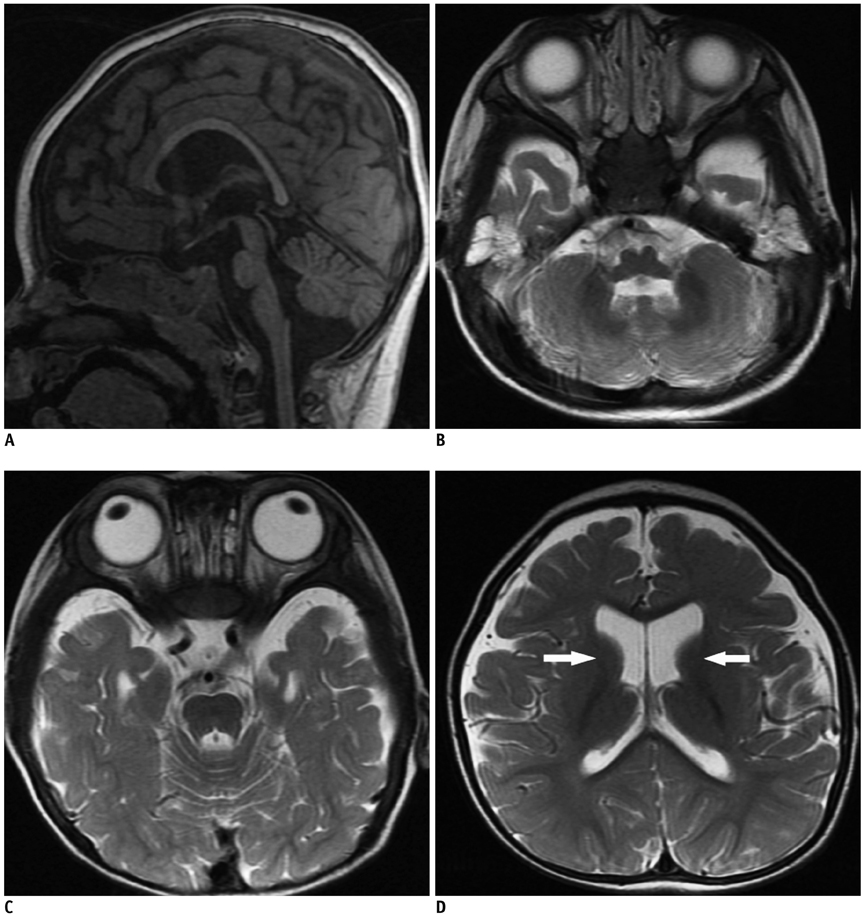Korean J Radiol.
2013 Dec;14(6):960-962. 10.3348/kjr.2013.14.6.960.
Brain Stem Hypoplasia Associated with Cri-du-Chat Syndrome
- Affiliations
-
- 1Department of Radiology, Inha University Hospital, Inha University School of Medicine, Incheon 400-711, Korea. pengoon@gmail.com
- KMID: 1711464
- DOI: http://doi.org/10.3348/kjr.2013.14.6.960
Abstract
- Cri-du-Chat syndrome, also called the 5p-syndrome, is a rare genetic abnormality, and only few cases have been reported on its brain MRI findings. We describe the magnetic resonance imaging findings of a 1-year-old girl with Cri-du-Chat syndrome who showed brain stem hypoplasia, particularly in the pons, with normal cerebellum and diffuse hypoplasia of the cerebral hemispheres. We suggest that Cri-du-Chat syndrome chould be suspected in children with brain stem hypoplasia, particularly for those with high-pitched cries.
MeSH Terms
Figure
Cited by 1 articles
-
Pontine Hypoplasia and Cri-du-chat Syndrome in a Preterm Infant
Yu Jin Jung
Kosin Med J. 2018;33(1):117-121. doi: 10.7180/kmj.2018.33.1.117.
Reference
-
1. Tamraz J, Rethoré MO, Lejeune J, Outin C, Goepel R, Stievenart JL, et al. [Brain morphometry using MRI in Cri-du-Chat Syndrome. Report of seven cases with review of the literature]. Ann Genet. 1993; 36:75–87.2. De Michele G, Presta M, Di Salle F, Serra L, Mazzaccara A, Della Rocca G, et al. Cerebellar vermis hypoplasia in a case of cri-du-chat syndrome. Acta Neurol (Napoli). 1993; 15:92–96.3. Arts WF, Hofstee Y, Drejer GF, Beverstock GC, Oosterwijk JC. Cerebellar and brainstem hypoplasia in a child with a partial monosomy for the short arm of chromosome 5 and partial trisomy for the short arm of chromosome 10. Neuropediatrics. 1995; 26:41–44.4. Ninchoji T, Takanashi J. Pontine hypoplasia in 5p-syndrome: a key MRI finding for a diagnosis. Brain Dev. 2010; 32:571–573.5. Selim LA, Zaki MS, Hussein HA, Saleem SN, Kotoury AS, Issa MY. Developmental abnormalities of mid and hindbrain: A study of 23 Egyptian patients. Egypt J Med Hum Genet. 2008; 9:215–236.6. Vialard F, Robyr R, Hillion Y, Molina Gomes D, Selva J, Ville Y. Dandy-Walker syndrome and corpus callosum agenesis in 5p deletion. Prenat Diagn. 2005; 25:311–313.7. Barkovich AJ, Millen KJ, Dobyns WB. A developmental classification of malformations of the brainstem. Ann Neurol. 2007; 62:625–639.8. Kjaer I, Niebuhr E. Studies of the cranial base in 23 patients with cri-du-chat syndrome suggest a cranial developmental field involved in the condition. Am J Med Genet. 1999; 82:6–14.
- Full Text Links
- Actions
-
Cited
- CITED
-
- Close
- Share
- Similar articles
-
- Lack of Myelination in the Anterior Limbs of the Internal Capsule Associated with Cri-du-Chat Syndrome: Case Report
- Cri-du-chat Syndrome with Dysphagia
- Pontine Hypoplasia and Cri-du-chat Syndrome in a Preterm Infant
- Brain MRI Findings of the Cri-Du-Chat Syndrome: A Case Report and Summary
- Two Cases of Cri Du Chat(5p-) Syndrome


